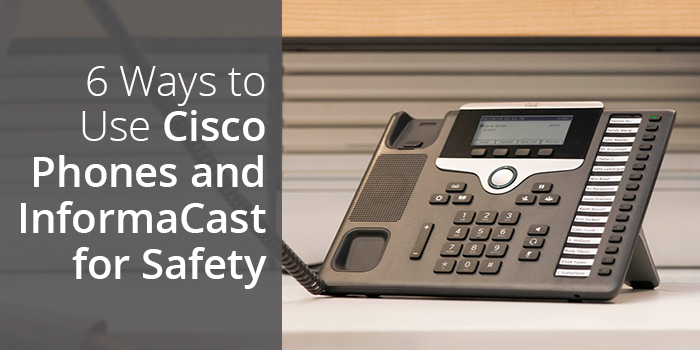Cisco Phones for Safety
When it comes to mass notifications, speed and reach are the keys to keeping people safe. Being able to quickly send a message to a large number of devices helps ensure everyone is informed about a potentially dangerous situation.
This was, and continues to be the guiding principle behind our partnership with Cisco. While our original functionality focused on live audio paging, IP phones deployed throughout large enterprises or campuses can now take advantage of a wide range of safety features they can activate without logging into anything or leaving their desks. Because there’s nothing more convenient for sending emergency alerts than a tool that is within arms reach.
In this blog post, we’ll go over the six ways Cisco phones can be used for safety with help from our InformaCast mass notification software.
1. Live Audio Paging
Let’s start with the basics. Live audio paging offers a quick and intrusive method to deliver safety information directly where people work. By simply picking up a phone and pressing a button (or entering a code), users can broadcast to Cisco IP phones throughout an organization. This offers a much more convenient and reliable method for reaching large groups or people than calling, which may not go through as placing a large number of calls at once can be seen as an attack and result in a denial of services.
2. Recorded Audio Messages
Users can also record messages that are then broadcast, or activate prerecorded messages right from their phone as well. This can again be activated by entering a speed dial code or pressing a preconfigured button on their Cisco IP phone. Recorded messages can sometimes have an advantage over live audio messages as they can be planned ahead of time to ensure the instructions being communicated are clear.
3. Panic Buttons
With InformaCast, virtual panic buttons can be configured on Cisco IP phones to activate prerecorded messages as previously mentioned, and activate other emergency procedures like lockdowns. With the proper configurations, the button pressed on a Cisco phone can lock doors, light up strobes, display messages on digital signage and trigger computer desktop notifications.
4. Visual Displays
In addition to the intrusive audio component, messages delivered as text can be displayed on Cisco IP phones that have screens. These messages can be customized with colors that align with an organization or represent a particular threat, and can also include an image if desired. This makes notifications more accessible and reduces the chance someone misses a message.
5. Confirmation Responses
When a message is sent to the visual display it can ask for a response for the recipient. The prompt could ask if someone is safe or needs assistance, and the recipient can reply by pressing a number or corresponding button on their Cisco phone. This will help administrators understand who needs help and where they can direct additional resources.
6. Alerts to All Devices
Of course, InformaCast works with far more devices than just Cisco phones. IP speakers, digital signage, mobile devices and more can all receive InformaCast mass notifications that are triggered by Cisco IP phones. The more channels your organization can leverage, the more likely you are to reach everyone and keep them out of harm’s way in the event of an emergency.
Visit our Technology Integrations page to learn more about connecting your existing devices to InformaCast.
